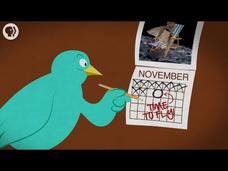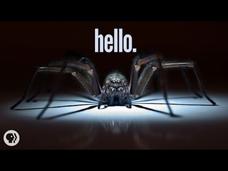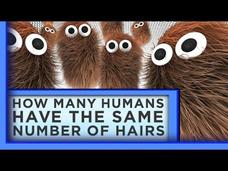Math & Learning Videos 4 Kids
Place Value Lesson
Support your place value instruction with an interactive, visual representation brought to you by a video that showcases the family of hundreds, tens, and ones.
Be Smart
Does The Moon Really Orbit The Earth?
What do Newton's Law of Gravitation and the moon's orbit have in common? Assist pupils as they view a short video segment and learn the gravitational methods of the moon and earth. They learn the reason why and how these have changed...
Be Smart
What's The Loudest Possible Sound?
If a tree falls in the forest and no person is around, does it still make a sound? Students view a short video segment to determine sound and decibel levels of various objects, including the loudest and quietest possible sounds humans...
Be Smart
The Physics of Space Battles
Ready to take your class on a journey through space and witness epic battles? A video segment portrays the true way space battles happen, complete with the way Hollywood handles the lack of gravity, even while firing missiles at the...
Be Smart
What Color is the Universe?
What colors are the sun, our galaxy, and the universe? An engaging video provides an overview of each and why what we think we are seeing is often wrong. It provides explanations for how to understand colors that aren't in the...
Be Smart
The Sun Is A Magnet!
Attract learners to science by studying largest magnet in the galaxy. The video explains why the sun is technically a magnet and how the magnetic fields causes solar storms. It also covers the effects of solar storms on the earth such as...
SciShow
Great Minds: James Hutton, Founder of Geology
Don't get sedimental when you learn the history of geology. The video focuses on James Hutton who, in the 1700s, came up with a theory based on rock layers. Without using any modern dating tools, he was able to theorize the earth was...
Be Smart
How Many Smells Can You Smell?
Do you know what doesn't stink? This resource! The video explains how people can smell, when they start smelling, and the changing idea of how many different smells individuals can identify. It introduces the concept of olfactory...
Be Smart
The Science of Marathon Running
The science of marathon running is the subject of a resource that begins with the history of the marathon and why it is 26.2 miles long, and then goes into the biology in our bodies and the way our muscles, bones, and other physical...
Be Smart
The Strange Science of the Placebo Effect
Scholars see how doctors first used placebos to help soldiers during WWII with pain. Viewers then see what placebos are and how effective they can be. The narrator reminds viewers that while placebos cannot cure everything,...
Be Smart
Why Do We Have To Sleep?
Humans are the only mammals who delay sleep. Viewers learn this and other interesting facts in a video that explores sleep in humans. The narrator also discusses how lights affect our sleep, the importance of sleep, and how...
Be Smart
Rise of the Superbugs
The narrator of a short video shows learners the history of antibiotics with the use of penicillin. Viewers then see how bacteria are becoming resistant to antibiotics and what that means for our future health and for the...
Be Smart
Where Do Birds Go In Winter?
The poet Homer believed that birds went to battle tribes of goat-riding dwarfs during the winter. As the video explains, this myth and many others that seem crazy to us now, wasn't questioned for many years. The reality isn't quite as...
Be Smart
Why I'm Scared of Spiders
Eighty-four percent of people have an irrational fear. This video focuses on a fear of spiders. It explains the different types of fear, the conditioning that creates fear, and the evolutionary advantage to these fears. It doesn't just...
PBS
When Pi is Not 3.14
Isn't pi supposed to be constant? An intriguing video shows how the value of pi can change when the definition of distance varies. It explains how using various L^p metrics, where p = 2 represents the traditional Euclidean metric,...
PBS
Can We Hear Shapes?
What do shapes sound like? Scholars learn about the frequencies of pure tones created by vibrations of shapes. The video first considers the case of string, then moves on to two dimensions. It touches upon Fourier series and a question...
PBS
Can You Solve the Poison Wine Challenge?
A video posits the question of how to identify the one poisoned bottle of wine from 1,000 bottles by getting 10 rats to drink the wine. Hint: Binary numbers become very useful in this situation.
PBS
A Hierarchy of Infinities
What's larger than infinity? Infinity plus one! Scholars learn about the different levels of infinity in the video that uses bijections as a way to show infinite sets as being the same size. They also and see that the set of real...
PBS
How Many Humans Have the Same Number of Body Hairs?
Is there a person on Earth who has the same exact number of body hairs as you? The video describes a process using the Pigeonhole Principle to prove that this is definitely possible. The film goes on to consider other examples and...
PBS
Are Prime Numbers Made Up?
Is math real? Scholars first learn about the Goldbach conjecture and prime numbers as an introduction to the philosophical idea of whether numbers actually exist. The video continues on to use an example of a circle to consider math from...
PBS
A Breakthrough in Higher Dimensional Spheres
How would you stack oranges in eight dimensions? The interesting video first describes hyperspheres as spheres in higher dimensions. It then provides some thought experiments to provide ways to think about hyperspheres and sphere packing.
Crash Course
Early Computing: Crash Course Computer Science #1
A generation brought up with computers probably can't imagine a world without them. The first video in the series explains advances in early computing. From the abacus to tabulating machines, individuals see how computations were made...
MinutePhysics
How to Simulate the Universe on Your Laptop
Ever grow tired of the traditional uses for laptops? Try this fascinating simulated universe! The video shows a 3-D version of the Millennium Run, then backs it up with a simpler version created in free Adobe software. Young physicists...
Crash Course
Instructions and Programs: Crash Course Computer Science #8
Scholars receive instruction on writing instructions as they learn how to develop computer programs in the eighth video of the series. Animations show how computers carry out these instructions and programs.
Other popular searches
- Digital Storytelling
- Digital Photography
- Digital Clock
- Digital Media
- Digital Imaging
- Digital Art
- Digital Microscope
- Digital Video Camera
- Digital Self Portraits
- Digital and Analog Clocks
- Netiquette
- Digital Cameras

























